Daytona Beach International Airport (DAB)
Daytona Beach International Airport (DAB) is a multi-use airport serving air carriers, as well as corporate and general aviation operators. The airport is also home to numerous flight schools, including the Daytona Beach campus for Embry-Riddle Aeronautical University. The mix of traffic ranging from the professional airline pilot to pre-solo student pilots presents unique challenges to both pilots and controllers. View a printable Pilot Handbook of the DAB information found on this Web page.
Know Before You Go
The airport configuration consists of parallel RWYs 7L/25R and 7R/25L with intersecting RWY 16/34.
The airspace at DAB is Class C. (Refer to Sectional Chart)
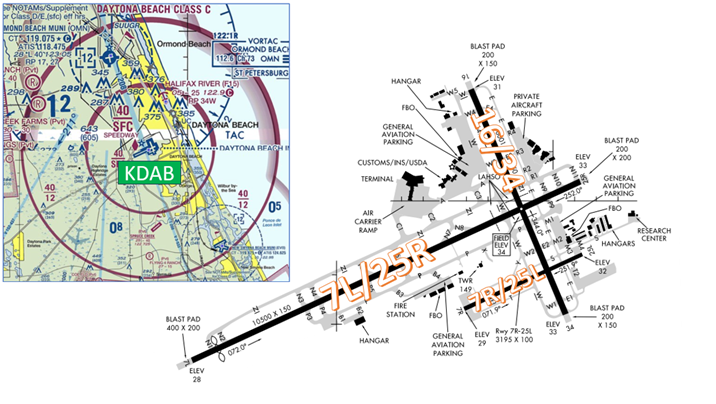
Below find various DAB-specific information and things to be aware of, as well as general information to inform your preflight planning. This will be reviewed quarterly and updated as needed. This information is to supplement the From the Flight Deck Videos that are produced by the FAA Runway Safety Group. Here you will also find information provided by the local air traffic controllers at the airport where you intend to fly. The information is subject to change. Not for navigation or legal* pre-flight action. Always refer to official pre-flight materials such as, but not limited to, NOTAMs, airport diagrams, VFR charts and airport construction notices for the latest airport-specific details.
DAB Tower Operates 24 Hours
Administrative Office Open 0730L-1600L M-F
Business Phone 386-226-3902
Wrong Surface Landing Risk
- Parallel RWYs with staggered thresholds present the risk of landing on the wrong RWY.
- Whenever a TWY runs parallel to a RWY, the risk of a TWY landing increases.
- When RWYs are staggered, remember that the first RWY that becomes visible may not be your assigned RWY.
- RWY 7L/25R is approximately one-third wider and more than three times longer than RWY 7R/25L. RWY 7L/25R has an ILS, precision approach markings, an approach lighting system, and over-runs with the yellow chevrons at both ends. RWY 7R/25L has Runway End Identifier Lights (REILS).
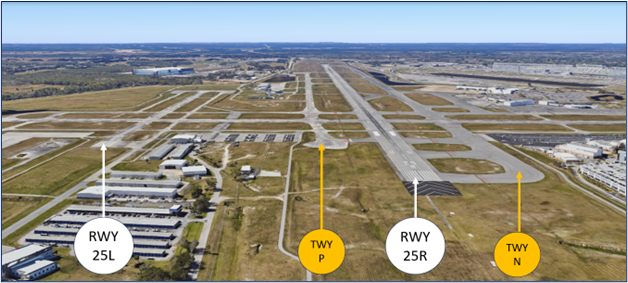
- Pilots approaching from the south sometimes mistake TWY P for RWY 7R and also TWY N for RWY 7L.
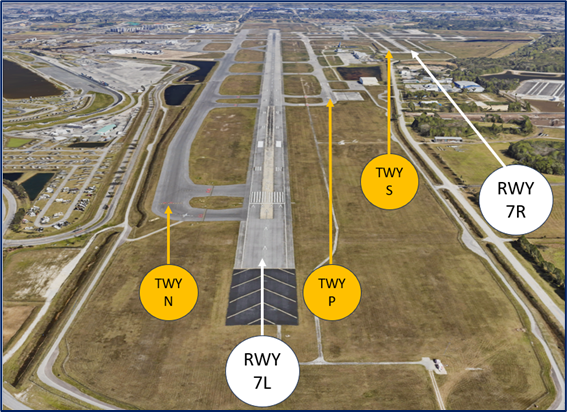
- RWY Markings are white. Markings on surfaces not used for takeoff/landing like TWY markings, chevrons, RWY shoulder and RWY turn-on markings etc., are yellow.
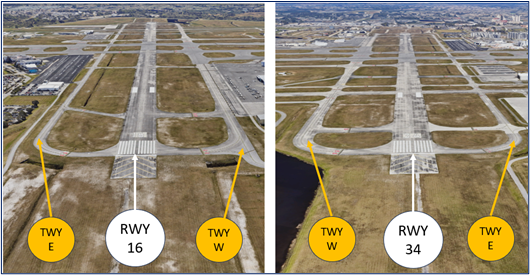
- If available, back up all visual approaches with an instrument approach/GPS waypoint to help ensure that you are lined up for the correct surface.
- Pilots should review NOTAMS for the Letter to Airmen LTA-DAB-7 “Verify Aligned with Correct Runway” for more detailed information.
- View the From the Flight Deck-Wrong Surface Landings video for additional mitigation strategies.
Wrong Runway Departure Risk
- At DAB, or at any airport where intersection take-offs are utilized, there is the risk that pilots will turn in the wrong direction when entering the RWY.
- The illustration below depicts the intersection of RWY 7L/25R at TWYs P5 and N5 (from both sides of the RWY). If approaching the RWY from the opposite direction, the RWY markings will have the position of the numbers reversed.
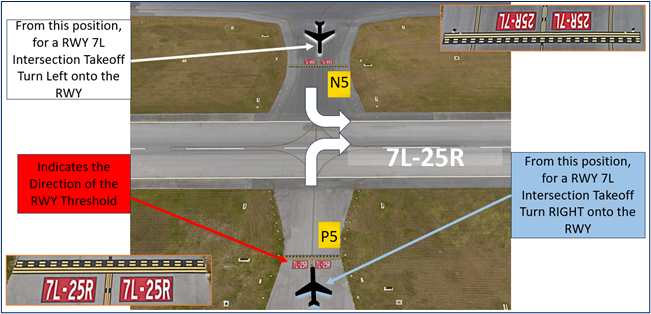
- Prior to entering the RWY and again when lining up on the RWY, check your Magnetic Compass and, your Horizontal Situation Indicator (HSI), if installed, to verify that you are pointed in the correct direction.
- View the From the Flight Deck-Wrong Direction Intersection Takeoffs video for more information and mitigation strategies.
General
- The high concentration of flight schools at KDAB introduces hundreds of new students to flying annually. RWY 25L is primarily utilized for practice takeoff and landings. Pilots with little experience utilize this RWY the majority of the time.
- Training aircraft in the pattern for Runway 25L do not always report traffic for RWY 25R in sight increasing controller workload and potentially becoming a conflict for that traffic.
- Pilots should review NOTAMS for the Letter to Airmen LTA-DAB-6 “Overshooting Parallel Runway Final” for more detailed information.
- RWY 7L has a displaced threshold. The portion of RWY behind a displaced threshold is available for takeoffs in either direction or landings from the opposite direction.
Traffic Patterns
- RWY 7R/25L traffic pattern is on the south side of the RWY.
- Right traffic for RWY 7R; Left traffic for RWY 25L.
- Pattern altitude 1,000 feet.
- Aircraft will be advised by Approach Control to maintain 1,500 feet until advised by the tower when landing RWY 7R/25L.
Ground Control
- Daytona Beach has a complex TWY system. Do not hesitate to ask for progressive taxi instructions to your FBO.
Takeoff/Departure
- Monitor the ATIS prior to contacting Clearance Delivery.
- When you are ready to taxi contact Ground Control on 121.9.
- Tower frequencies are 120.7 (7L/25R) and 118.1 (7R/25L).
- DAB utilizes “Line Up and Wait” (LUAW) to instruct a pilot to taxi onto the departure runway and hold position until cleared for takeoff. It is not authorization for takeoff. For mitigation strategies, view the From the Flight Deck-Line Up and Wait video.
Arrival/Landing
- Pilots landing RWY 7L/25R expect vectors for sequencing to a straight in approach.
- Pilots landing RWY 7R/25L expect sequencing to the midfield downwind at 1,500 MSL.
- Land & Hold Short (LAHSO) clearances may be issued to general aviation aircraft.
LDG RWY HOLD-SHORT POINT AVBL LDG DIST
RWY 7L TWY W 7500
RWY 16 7L/25R 2900
RWY 34 7L/25R 2564
- Daytona Beach Approach Control provides separation for VFR aircraft conducting practice instrument approaches subject to traffic and workload conditions.
- Pilots should review NOTAMS for the Letter to Airmen LTA-DAB-8 “Practice Instrument Approaches” for specific information.
Additional Information
- Use company fly quiet procedure or recommended noise abatement procedure.
- Pilots should expect busy frequencies and a high volume of traffic while arriving/departing DAB.
